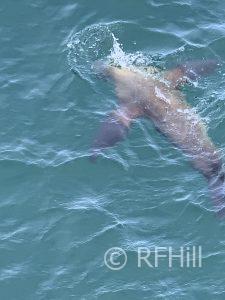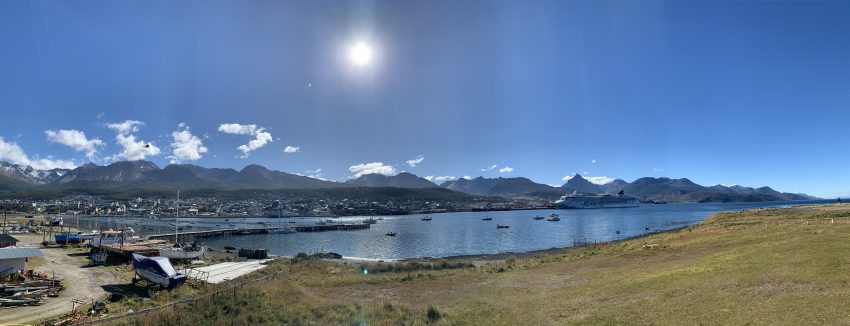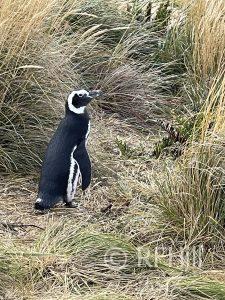Taking a Patagonia cruise was one of our most unique experiences. The wildlife was unparalleled. Patagonia offers numerous prime locations for wildlife spotting, each with its exceptional array of species.
The Valdés Peninsula in Argentina is a renowned hotspot for marine wildlife, including southern right whales, orcas, and Magellanic penguins, especially from June to December when these species come to breed and hunt. Unfortunately, we were there in March.
Torres del Paine National Park in Chile is a haven for land mammals such as guanacos, Andean condors, and the elusive puma. The park’s diverse landscapes provide ideal habitats for these creatures, and guided tours increase the chances of sightings. The coastal regions of Tierra del Fuego are home to colonies of sea lions and various seabirds, including the black-browed albatross.
For bird enthusiasts, the wetlands around Lago Argentino and Lago Viedma offer excellent opportunities to observe flamingos, black-necked swans, and other waterfowl. Additionally, the Beagle Channel, accessible from Ushuaia, provides chances to see dolphins and sea birds while enjoying the stunning marine scenery. Each of these locations not only offers incredible wildlife viewing but also spectacular natural beauty, making Patagonia a must-visit for nature lovers.
Unique Wildlife You Can Encounter in Patagonia
Mammals
- Guanaco: A wild relative of the llama, guanacos are commonly seen grazing in the Patagonian steppes and grasslands. They are agile and can be spotted in herds.
- Puma (Mountain Lion): Though elusive, pumas roam mountainous and forested regions and are top predators in the Patagonian ecosystem.
- Huemul (South Andean Deer): This endangered deer is Chile's national symbol. Spotting one is a rare and special experience.
- Patagonian Fox: Also known as the South American gray fox, these tiny predators can be seen in various habitats across Patagonia.

Birds
- Andean Condor: One of the world's most giant flying birds, the Andean condor can be seen soaring above the Andean peaks. Its wingspan is up to 3.3 meters (10.8 feet).
- Magellanic Penguin: These penguins nest in coastal colonies, with significant populations on Isla Magdalena and the Punta Tombo Peninsula.
- Black-necked Swan: Found in lakes and lagoons, these elegant birds are easily recognizable by their black necks and white bodies.
- Chilean Flamingo: These pink birds inhabit salt lakes and lagoons, adding colour to the landscape.
Marine Life

- Southern Right Whale: These majestic whales can be seen in the waters of the Valdés Peninsula during their breeding season, which runs from June to December.
- Orca (Killer Whale): Orcas are occasionally seen hunting along the coasts, particularly around the Valdés Peninsula.
- Sea Lions: Large colonies of South American sea lions can be observed basking on the shores and rocky islands.
- Dolphins: Various species of dolphins, including the Commerson's dolphin, are often seen in the coastal waters.
Reptiles and Amphibians
- Mata Mata Turtle: A rare and unique freshwater turtle in some Patagonian rivers.
- Patagonian Toad: This small amphibian can be found in the wetlands and forests.
Insects and Other Invertebrates
- Darwin's Beetle: This beetle is found in forested areas and is named after Charles Darwin, who collected specimens during his voyage on the HMS Beagle.
- Chilean Rose Tarantula: A species of tarantula that can be found in the drier regions of Patagonia.
One of Patagonia’s greatest appeals is its remoteness, which ensures fewer crowds and a more intimate connection with nature. This is not entirely true on cruises with hundreds of disembarking simultaneously. Many areas are protected as national parks, maintaining their pristine condition and allowing visitors to experience unspoiled wilderness. Culturally, Patagonia offers a rich tapestry of experiences, blending indigenous heritage with the traditions of the gauchos. Visitors can enjoy local cuisine, including Patagonian lamb, fresh seafood, and regional wines, adding a flavorful dimension to their adventure.
Covering approximately 1,043,076 square kilometres (402,734 square miles), Patagonia spans parts of Argentina and Chile, stretching from the Rio Colorado north to Tierra del Fuego south. This vast area includes regions such as Río Negro, Neuquén, Chubut, Santa Cruz, and Tierra del Fuego in Argentina, as well as Aysén and Magallanes in Chile.
Due to its remote location, Visiting Patagonia can be a bit challenging. Cruises offer a unique and convenient way to explore Patagonia's vast and remote landscapes, making them an excellent choice for travellers seeking adventure and comfort. One of the main advantages of a Patagonian cruise is the ability to access remote areas that are otherwise difficult to reach by land.
 Cruising through the fjords and channels of Patagonia allows visitors to witness breathtaking scenery, including towering glaciers, dramatic coastlines, and pristine wilderness areas, all from the comfort of their ship. Additionally, cruises often provide guided excursions led by knowledgeable naturalists, offering insights into the region's unique flora, fauna, and geological features.
Cruising through the fjords and channels of Patagonia allows visitors to witness breathtaking scenery, including towering glaciers, dramatic coastlines, and pristine wilderness areas, all from the comfort of their ship. Additionally, cruises often provide guided excursions led by knowledgeable naturalists, offering insights into the region's unique flora, fauna, and geological features.
Another benefit of choosing a cruise for us was the seamless travel experience it offers. With accommodations, meals, and transportation included, travellers can focus on enjoying their surroundings without the hassle of planning logistics. This is particularly valuable in a region like Patagonia, where distances are vast, and infrastructure can be limited.
Moreover, cruises provide a comfortable base to explore, ensuring a good night's rest and quality dining after days filled with adventure. This blend of comfort and exploration makes cruising an appealing option for those looking to experience the rugged beauty of Patagonia without sacrificing convenience and relaxation.
Ultimately, our Patagonian cruise offered an unparalleled way to immerse ourselves in one of the world's most stunning and remote regions, combining the thrill of discovery with the ease of organized travel.




